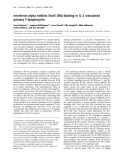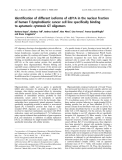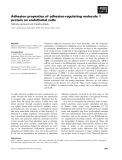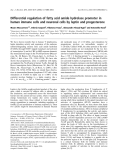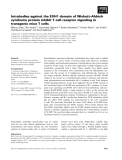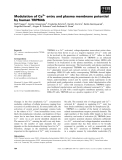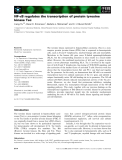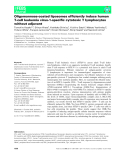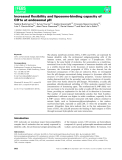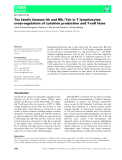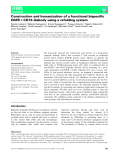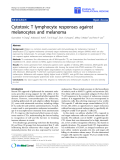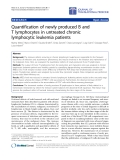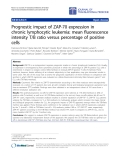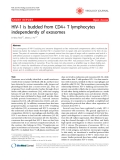
T lymphocytes
-
Bài giảng Các tế bào máu dòng lympho gồm các nội dung chính sau: Nguồn gốc biệt hóa; Các quần thể TB lympho; Dòng lympho B; Quá trình biệt hóa; Dòng lympho T; Dòng NK; Rối loạn lymphocyte; Rối loạn chức năng.
 11p
11p  viprimi
viprimi
 19-11-2024
19-11-2024
 2
2
 2
2
 Download
Download
-
It has previouslybeen shown that IFN-ais apotent inhibitor of IL-2 induced proliferation in primary T-lymphocytes, by selectively abrogating the downstream eects of IL-2 on the core cell cycle machinery regulating the G1/S transition. Theoretically this could be mediated through cross-talk between the signalling cascades activated by these cytokines, as several signalling components are known to be shared.
 9p
9p  research12
research12
 29-04-2013
29-04-2013
 45
45
 4
4
 Download
Download
-
GToligomers, showingadose-dependent cytotoxic effect on a variety of human cancer cell lines, but not on normal human lymphocytes, recognize and form complexes with nuclear proteins.By working with human T-lymphoblastic CCRF-CEM cells and by using MS and SouthWestern blotting, we identified eukaryotic elongation factor 1 alpha (eEF1A) as the main nuclear protein that specifically recognizes these oligonucleotides.Western blotting and supershift assays confirmed the nature of this protein and its involvement in forming a cytotoxicity-related complex (CRC)....
 12p
12p  tumor12
tumor12
 20-04-2013
20-04-2013
 34
34
 1
1
 Download
Download
-
Jurkat T lymphocytes were treated with daunorubicin and WP631, a daunorubicin-based DNAbinding agent, in experiments aimed to analyze cellular uptake of these drugs and their effect on cell viability. WP631 was taken up more slowly than daunorubicin, but laser confocal microscopy and spectrofluorometricquantificationshowed that thedrug accumulated in the cells. Despite the slow uptake rate, the antiproliferative capacity of WP631 (measured as IC50after a 72-h continuous treatment) was greater than that of daunorubicin.
 7p
7p  tumor12
tumor12
 20-04-2013
20-04-2013
 39
39
 5
5
 Download
Download
-
Dipeptidyl peptidase IV (DP IV, CD26) plays an essential role in the activation and proliferation of lymphocytes, which is shown by the immunosuppressive effects of syn-thetic DP IV inhibitors. Similarly, both human immuno-deficiency virus-1 (HIV-1) Tat protein and the N-terminal peptide Tat(1–9) inhibit DP IV activity and T cell prolifer-ation. Therefore, the N-terminal amino acid sequence of HIV-1 Tat is important for the inhibition of DP IV.
 10p
10p  fptmusic
fptmusic
 16-04-2013
16-04-2013
 33
33
 4
4
 Download
Download
-
Báo cáo khoa học: Adhesion properties of adhesion-regulating molecule 1 protein on endothelial cells
Numerous adhesion molecules have been described, and the molecular mechanisms of lymphocyte trafficking across the endothelium is starting to be elucidated. Identification of the molecules involved in the organoselec-tivity of this process would help in the targeting of drug therapy to specific tissues. Adhesion-regulating molecule-1 (ARM-1) is an adhesion-regulating molecule previously identified on T cells. It does not belong to any known families of adhesion molecules.
 12p
12p  awards
awards
 06-04-2013
06-04-2013
 35
35
 4
4
 Download
Download
-
Báo cáo khoa học: Identification and characterization of novel PKA holoenzymes in human T lymphocytes
Cyclic AMP-dependent protein kinase (PKA) is a holoenzyme that consists of a regulatory (R) subunit dimer and two catalytic (C) subunits that are released upon stimulation by cAMP. Immunoblotting and immunoprecipita-tion of T-cell protein extracts, immunofluorescence of permeabilized T cells and RT⁄PCR of T-cell RNA using C subunit-specific primers revealed expression of two catalytically active PKA C subunits Ca1 (40 kDa) and Cb2 (47 kDa) in these cells.
 0p
0p  awards
awards
 06-04-2013
06-04-2013
 39
39
 3
3
 Download
Download
-
We have shown recently that in human T lymphocytes, leptin stimulates activity and expression of the endocan-nabinoid-degrading enzyme fatty acid amide hydrolase (FAAH), through STAT3 (signal transducer and activator of transcription 3) and its CRE (cAMP response element)-like transcriptional target in the FAAH promoter [Maccar-rone, M., Di Rienzo, M., Finazzi-Agro`,A., &Rossi,A. (2003) J. Biol. Chem. 278, 13318–13324]. We have also shown that progesterone, alone or additively with leptin, up-regulates theFAAHgene in human T-cells, through the Ikaros transcription factor [Maccarrone, M.
 11p
11p  awards
awards
 05-04-2013
05-04-2013
 37
37
 3
3
 Download
Download
-
Intracellularly expressed antibodies (intrabodies) have been used to inhibit the function of various kinds of protein inside cells. However, problems with stability and functional expression of intrabodies in the cytosol remain unsolved. In this study, we show that single-chain variable fragment (scFv) intrabodies constructed with a heavy chain variable (VH) leader signal sequence at the N-terminus were translocated from the endoplasmic reti-culum into the cytosol of T lymphocytes and inhibited the function of the target molecule, Wiskott–Aldrich syndrome protein (WASP)....
 14p
14p  dell39
dell39
 27-03-2013
27-03-2013
 41
41
 5
5
 Download
Download
-
TRPM4b is a Ca 2+ -activated, voltage-dependent monovalent cation chan-nel that has been shown to act as a negative regulator of Ca 2+ entry and to be involved in the generation of oscillations of Ca 2+ influx in Jurkat T-lymphocytes. Transient overexpression of TRPM4b as an enhanced green fluorescence fusion protein in human embryonic kidney (HEK) cells resulted in its localization in the plasma membrane, as demonstrated by confocal fluorescence microscopy.
 10p
10p  galaxyss3
galaxyss3
 21-03-2013
21-03-2013
 34
34
 3
3
 Download
Download
-
The tyrosine kinase expressed in hepatocellular carcinoma (Tec) is a non-receptor protein tyrosine kinase (PTK) that is expressed in hematopoietic cells, such as B and T lymphocytes, myeloid lineage cells and neutrophils. Mutations in the humanBtkgene cause X-linked agammaglobulinemia (XLA), but the corresponding mutation in mice results in a much milder defect.
 11p
11p  viettel02
viettel02
 20-02-2013
20-02-2013
 32
32
 3
3
 Download
Download
-
Although thiazolidinediones (TZDs) are potent promoters of adipogenesis in the preadipocyte, they induce apoptosis in several other cell types, such as cancer cells, endothelial cells and T-lymphocytes. In this study, we investigated the proapoptotic effect of TZDs in mature 3T3-L1 adipocytes, which express high levels of the peroxisome proliferator-acti-vated receptor-c (PPARc) protein.
 10p
10p  mobifone23
mobifone23
 18-01-2013
18-01-2013
 49
49
 3
3
 Download
Download
-
Human T-cell leukemia virus-1 (HTLV-1) causes adult T-cell leuke-mia⁄lymphoma, which is an aggressive peripheral T-cell neoplasm. Insuffi-cient T-cell response to HTLV-1 is a potential risk factor in adult T-cell leukemia⁄lymphoma.
 9p
9p  cosis54
cosis54
 05-01-2013
05-01-2013
 35
35
 3
3
 Download
Download
-
The plasma membrane proteins CD1a, CD1b and CD1c are expressed by human dendritic cells, the professional antigen-presenting cells of the immune system, and present lipid antigens to T lymphocytes. CD1e belongs to the same family of molecules, but accumulates as a membrane-associated form in the Golgi compartments of immature dendritic cells and as a soluble cleaved form in the lysosomes of mature dendritic cells.
 12p
12p  cosis54
cosis54
 05-01-2013
05-01-2013
 50
50
 4
4
 Download
Download
-
Developing thymocytes and T cells express the Tec kinases Itk, Rlk⁄Txk and Tec, which are critical modulators of T-cell receptor signaling, required for full activation of phospholipase Cc, and downstream Ca 2+ and ERK-mediated signaling pathways.
 10p
10p  cosis54
cosis54
 05-01-2013
05-01-2013
 47
47
 4
4
 Download
Download
-
We previously reported the construction and activity of a humanized, bispecific diabody (hEx3) that recruited T cells towards an epidermal growth factor receptor (EGFR) positive tumor. Herein, we describe the construction of a second functional, fully humanized, anti-EGFR bispecific diabody that recruits another subset of lymphocyte effectors, the natural killer cells, to EGFR-expressing tumor cells.
 11p
11p  cosis54
cosis54
 08-12-2012
08-12-2012
 43
43
 3
3
 Download
Download
-
Tuyển tập báo cáo các nghiên cứu khoa học quốc tế ngành hóa học dành cho các bạn yêu hóa học tham khảo đề tài: Cytotoxic T lymphocyte responses against melanocytes and melanoma
 10p
10p  dauphong6
dauphong6
 05-01-2012
05-01-2012
 50
50
 5
5
 Download
Download
-
Tuyển tập báo cáo các nghiên cứu khoa học quốc tế ngành hóa học dành cho các bạn yêu hóa học tham khảo đề tài: Quantification of newly produced B and T lymphocytes in untreated chronic lymphocytic leukemia patients
 7p
7p  dauphong4
dauphong4
 03-01-2012
03-01-2012
 62
62
 6
6
 Download
Download
-
Tuyển tập báo cáo các nghiên cứu khoa học quốc tế ngành hóa học dành cho các bạn yêu hóa học tham khảo đề tài: Prognostic impact of ZAP-70 expression in chronic lymphocytic leukemia: mean fluorescence intensity T/B ratio versus percentage of positive cells
 11p
11p  dauphong4
dauphong4
 03-01-2012
03-01-2012
 58
58
 6
6
 Download
Download
-
Tuyển tập báo cáo các nghiên cứu khoa học quốc tế ngành y học dành cho các bạn tham khảo đề tài: HIV-1 is budded from CD4+ T lymphocytes independently of exosomes
 5p
5p  dauphong2
dauphong2
 23-12-2011
23-12-2011
 32
32
 2
2
 Download
Download
CHỦ ĐỀ BẠN MUỐN TÌM










